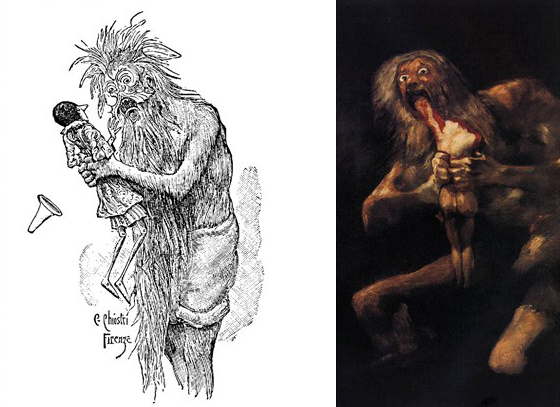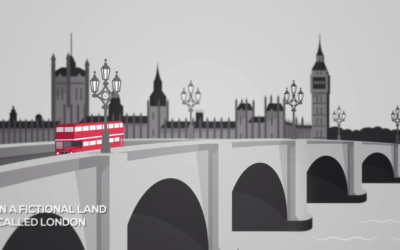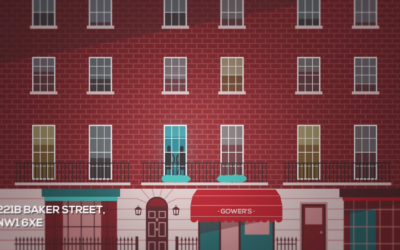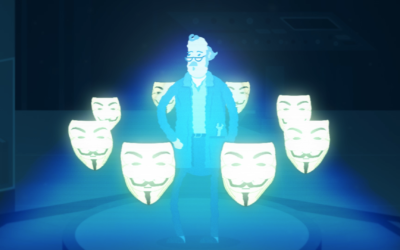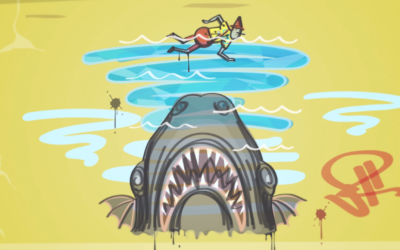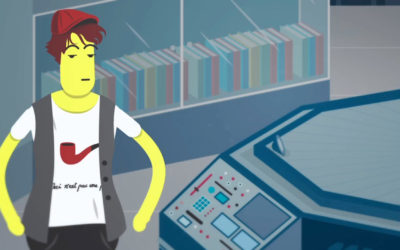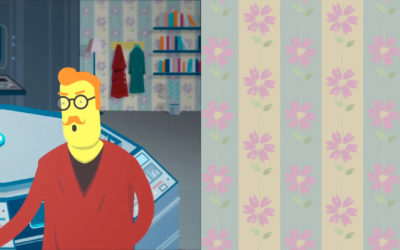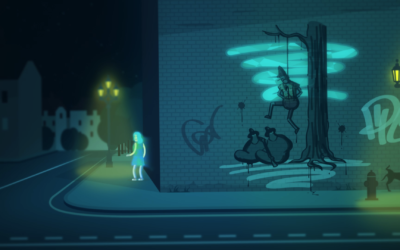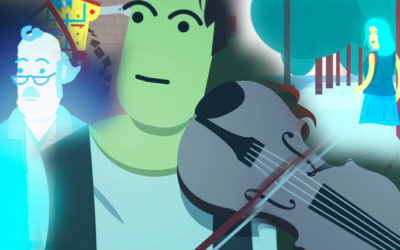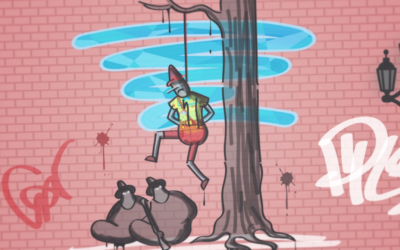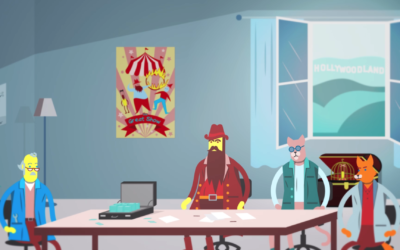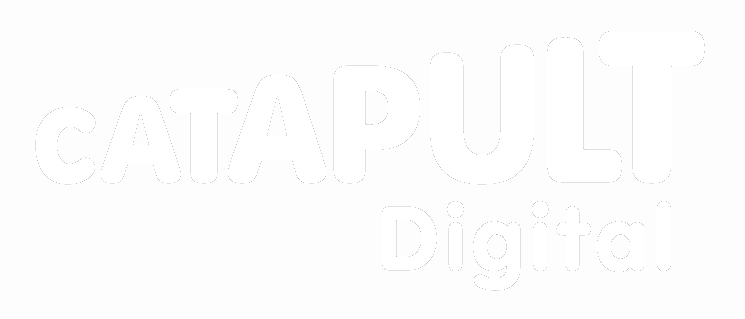2. THE MONSTER
One of the graffiti that scare the toymaker Joseph portrays a monster eating his ‘beautiful, wonderful toy’. The image of the monster is inspired by two different artistic works: a drawing of the Green Fisherman eating Pinocchio by Carlo Chiostri (1863 – 1939), who illustrated one of the first editions of Carlo Collodi’s (1826 – 1890) The Adventures of Pinocchio, and the famous painting by Francisco Goya (1746 – 1828) Saturn Devouring His Son. In producing our graffiti of the monster, we were free to mash-up those works of art as we wished, since both works are out of copyright.
This Case File #2 considers the length of time that copyright normally lasts, and what it means when a work is in the public domain.
COPYRIGHT DURATION: LIFETIME OF THE AUTHOR + 70 YEARS
In the UK, generally copyright lasts for the life of the author plus 70 years. After that period of time (often referred to as the ‘copyright term’), copyright expires and the works of the author enter the public domain. Public domain works can be used for free by anyone for any purpose, without having to ask for permission. So in order to know if a work is in the public domain in the UK you need to identify its creators – bearing in mind that a single work can have more than one creator – and check the date of their death. If the creator(s) died more than 70 years ago the work is in the public domain and free to be used by all (at least in theory).
For example, anyone is free to create a video game based on the painting The Starry Night by Vincent Van Gogh (1853 – 1890) or use the Symphony No. 9 of Ludwig van Beethoven (1770 – 1827) as part of a soundtrack to a film, since both Van Gogh and Beethoven died more than 70 years ago. The video game and the film would be protected by copyright as new, original works, whereas Van Gogh’s The Starry Night and Beethoven’s Symphony No. 9 remain in the public domain. Indeed, an adaptation of a public domain work creates a new copyright work with a new ‘copyright life’. But this has no effect on the public domain status of the underlying work: everyone remains free to make use of Van Gogh’s and Beethoven’s work in whatever way they want. Similarly, if you want to create a video based on The Jungle Book, you are free to use Kipling’s stories (Rudyard Kipling, 1865 – 1936); but to use clips from Disney’s movie adaptation would require permission from the rightsholders.
There are two other important things to bear in mind when dealing with public domain works:
Copyright law differs from country to country
A work that is in the public domain in the UK is not necessarily in the public domain in the US as well (and vice versa). This is because each country’s copyright law is different (in legal terms: copyright law is territorial).
The difference between an original work and its reproduction
It is important to know that while an original work might be out of copyright, a later reproduction or recording of that work might be in copyright. For example, while the music for Beethoven’s Symphony No. 9 is out of copyright, a recording of that work made in 2009 by the London Philharmonic Orchestra is in copyright. So in order to use Symphony No. 9 without the need to clear any rights at all, you should find a recording that is free to use, for example, because it is distributed under an open licence such as Creative Commons. You can find classical music distributed under Creative Commons licences on FreePD.com and on Kevin MacLeod’s Incompetech.com.
Similarly, a photographic reproduction of a work of sculpture in the public domain, such as Michelangelo’s (1475 – 1564) David, or the works of the 19th century Scottish sculptor John Henning (1771 – 1851), may be considered protected by copyright.
However, whether a photograph of a painting (or any other two-dimensional work of art) attracts copyright protection is a more controversial and unsettled issue. So, if you wanted to use a photograph of Van Gogh’s The Starry Night without having to get permission, the safest thing to do would be to find one that has been distributed under an open licence. A good source for this is Wikimedia Commons.
CURIOSITIES
Although JM Barrie died in 1937, his most famous work, Peter Pan, is still in copyright. An amendment to the 1988 Copyright Designs and Patents Act was passed to allow the copyright for Peter Pan to run indefinitely in the UK; royalties are to be allocated to the trustees of the Hospital for Sick Children, Great Ormond Street, London, for as long as the hospital exists.
Also, some very old unpublished works remain in copyright until 31 December 2039, even though their authors have been dead for hundreds of years. Imagine, for example, that you discovered an unpublished manuscript by William Shakespeare. As incredible as it seems, that unpublished manuscript would still be in copyright today.
FOR DISCUSSION: TOO LONG, NOT LONG ENOUGH, OR JUST RIGHT?
The ultimate goal of copyright is the creation and spread of knowledge. To achieve this goal, copyright needs to strike a fair balance between the interests of authors and creators, and the interests of the general public. By giving creators economic and personal rights, copyright allows them to be rewarded for their efforts, thereby promoting the creation of new work. At the same time, copyright puts some limits on those rights in order to encourage learning and access to information and knowledge. One of these limits is the copyright term explained above: after a certain period of time, copyright expires and the work can be freely enjoyed and re-used by the members of society.
What do you think? Is the current copyright term appropriate?
USEFUL REFERENCES
For useful information on the creative re-use of public domain works, see: www.create.ac.uk.
For a guide to the copyright term and the public domain in the US, take a look at this useful resource produced by the Cornell Copyright Information Centre.
For a resource to help you calculate whether a work is in the public domain in the UK or other EU Member States, see www.outofcopyright.eu.
For further information about the copyright status of Peter Pan, see www.gosh.org.
For further information on the odd situation of unpublished works, see www.gov.uk.
Download the PDF version of Case File #2 – The Monster.
More Case Files
1. The Red Bus
The Adventure of the Girl with the Light Blue Hair starts with a red double-decker bus travelling across Westminster Bridge, with the Houses of Parliament in the background.
3. The Baker Street Building
Sherlock Holmes and John Watson discuss Joseph’s case at 221B Baker Street. The above illustration is inspired by two sources…
4. The Anonymous Artist
Joseph, the toymaker, has asked the police to identify the culprit making ‘dreadful images’ of his toy, portraying it in violent situations.
5. The Terrible Shark
This illustration from our video depicts a terrible shark-like creature about to eat Joseph’s toy. It was inspired by two different images…
6. The Famous Pipe
The pipe has been associated with the image of Sherlock Holmes since Sir Arthur Conan Doyle’s (1859 – 1930) stories were first published in The Strand Magazine with illustrations by Sidney Paget (1860 – 1908).
7. The Matching Wallpaper
In the background of Holmes and Watson’s apartment you can see wallpaper with ‘flowers scattered over it in a somewhat impressionistic style’.
8. The Dreadful Images
The ‘dreadful images’ that scare Joseph, the toymaker, are graffiti drawn all over the ‘fictional land called London’. The illustration above, depicting Joseph’s toy hung from a tree, is based on an actual place in London.
9. The Improbable Threat
In trying to persuade Holmes to take Joseph’s case, Watson asks: ‘What if it’s a threat? That’s what the graffiti might mean.’ These eleven words are based on dialogue from The Blind Banker…
10. The Uncertain Motivation
Joseph, Sherlock Holmes and the Girl with the Light Blue Hair are all creators: Joseph draws and designs toys; Sherlock composes music; and the mysterious girl is an accomplished street artist.
11. The Mutilated Work
In trying to persuade Holmes to take the case, Watson argues that: ‘If you were a professional musician, you wouldn’t want people copying or mutilating your work’.
12. The Hollywoodland Deal
Joseph explains to Holmes and Watson when and why the dreadful images of his beautiful, wonderful toy began to appear all over London. When ‘some guys’ from Hollywoodland approached him ‘to option a movie’…

